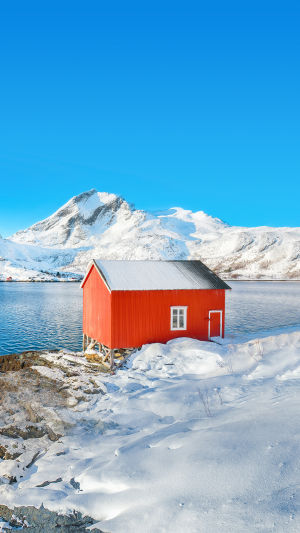Norway is an enchanting destination, especially in winter, when the snow-covered landscapes and vibrant coastal villages create a magical atmosphere. Known for its dramatic fjords, northern lights, and cozy red cabins like the one pictured, Norway is a winter paradise.
This travel guide provides Lykkers with tips and insights on how to explore Norway, from the best spots to visit to practical information about getting around.
<h3>Why Visit Norway in Winter?</h3>
<b>1. Northern Lights</b>
Norway is one of the best places to witness the northern lights, a natural light display that dazzles the sky with green, pink, and violet hues. Lykkers have a high chance of seeing this phenomenon from northern cities like Tromsø.
<b>2. Unique Architecture</b>
Red cabins, traditional Norwegian architecture, and modern wooden structures are scattered across Norway’s landscapes, providing a picturesque contrast to the snowy scenery. These charming homes offer great photo opportunities and a cozy Nordic vibe.
<b>3. Adventure Activities</b>
Norway in winter isn’t just about stunning views; it’s also an adventure playground. With options like dog sledding, snowshoeing, and ice fishing, Norway is a prime destination for outdoor enthusiasts.
<h3>Key Destinations for Lykkers</h3>
<b>Lofoten Islands</b>
Known for their rugged landscapes, fishing villages, and distinctive red cabins, the Lofoten Islands are a dream destination for photographers. The islands offer breathtaking views of snow-dusted mountains rising from the sea, making them an ideal spot for hiking and exploring coastal beauty.
<b>Entry Fee</b>: Free
<b>Open Time</b>: Accessible year-round
<b>Traffic Time/Price</b>: Reachable via flights from Oslo to Leknes; round-trip tickets range from $150 to $250, depending on the season.
<b>Tromsø</b>
Often called the “Gateway to the Arctic,” Tromsø is famous for its northern lights and vibrant winter festivals. The city also offers scenic fjords and opportunities to visit reindeer farms. A cable car ride to Mount Storsteinen provides stunning panoramic views of the surrounding landscapes.
<b>Entry Fee</b>: Free for the city; cable car to Mount Storsteinen costs about $25
<b>Open Time</b>: Accessible year-round
<b>Traffic Time/Price</b>: A 2-hour flight from Oslo; average round-trip airfare is around $120.
<b>Geirangerfjord</b>
A UNESCO World Heritage site, Geirangerfjord is Norway’s most iconic fjord, featuring steep cliffs and frozen waterfalls in winter. Although it’s more commonly visited in summer, winter offers a quieter, serene experience of the fjord’s dramatic beauty.
<b>Entry Fee</b>: Free
<b>Open Time</b>: Winter access depends on weather, with some routes requiring snow tires
<b>Traffic Time/Price</b>: A 6-hour drive from Oslo; car rentals are around $50–$100 per day, depending on the season.
<h3>Travel Tips for Lykkers</h3>
<b>Best Time to Visit</b>
Norway’s winter season runs from November to March. The best months for the northern lights are December to February, as the long nights maximize viewing opportunities. Lykkers should be prepared for cold weather and shorter daylight hours, as it can get dark as early as 3 p.m. in winter.
<b>Getting Around</b>
Renting a car is a popular option for travelers who want the flexibility to explore remote areas. However, winter driving in Norway requires caution due to icy roads. Alternatively, Norway’s public transportation, including trains, buses, and ferries, is reliable and offers scenic routes. An unlimited public transportation pass costs around $100 for 7 days, covering most regions.
<b>Winter Activities</b>
Norway offers a range of winter activities beyond sightseeing. Try dog sledding in Tromsø, a popular winter sport that’s thrilling and offers a unique way to experience Norway’s Arctic landscape. Snowshoeing tours are available in most mountainous areas, allowing Lykkers to enjoy scenic hikes even in the snow.
<h3>Fun Facts About Norway</h3>
<b>Home of the Midnight Sun and Polar Night</b>
Depending on the season, parts of Norway experience either the midnight sun (24-hour daylight) in summer or the polar night (24-hour darkness) in winter. These phenomena are particularly visible in northern Norway.
<b>Norway’s Famous Red Cabins</b>
The iconic red cabins scattered across Norway’s landscapes date back centuries and are typically painted with a pigment made from iron oxide, making them highly durable against Norway’s climate. This tradition has become an iconic part of the country’s visual identity.
<b>Spectacular Fjords Formed by Glaciers</b>
Norway’s fjords were carved by glaciers during the Ice Age, creating steep, narrow inlets with deep blue waters. This geological history gives Norway its unique and dramatic landscape, making it a popular destination for nature lovers.
<h3>Final Thoughts</h3>
Norway’s breathtaking landscapes, vibrant northern lights, and charming villages make it a top destination for winter travel. With a combination of serene natural beauty and thrilling winter activities, Norway provides a memorable experience for Lykkers who crave adventure and tranquility alike.
From the tranquil shores of the Lofoten Islands to the majestic fjords, Norway’s winter wonderland is an unforgettable escape that brings travelers closer to nature in the heart of the Arctic.





